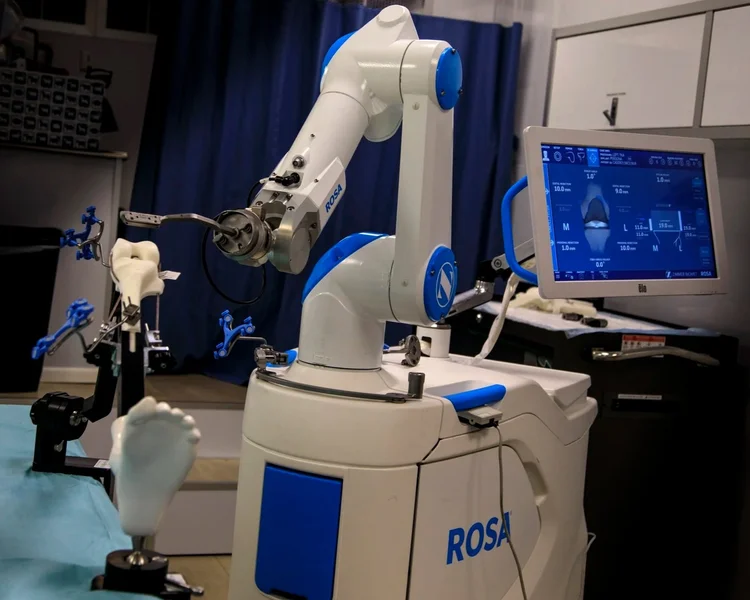Total knee replacement—also known as total knee arthroplasty—is a surgical procedure that replaces a worn or damaged knee joint with a precisely fitted artificial implant. Most commonly performed to treat severe osteoarthritis, this procedure is designed to eliminate chronic pain, restore mobility, and dramatically improve quality of life.
At American Orthopedics, Dr. Drew Ratner uses advanced robotic technology to personalize every knee replacement for optimal function and comfort.
Restore mobility and get back to doing what you love.
- Dr. Drew Ratner, MD, Board-Certified Orthopedic Surgeon
Patient of Dr. Ratner.
Before

After

Before

After

When it comes to joint replacement, your choice of surgeon makes all the difference. At American Orthopedics, you’re not just a number—you’re an individual receiving expert, personalized care from Dr. Rather, a highly skilled and compassionate provider.




Dr. Ratner is fellowship-trained in sports medicine and has specialized expertise in anterior hip replacement. He combines academic excellence with real-world athletic insight to deliver superior outcomes.
Unlike hospital systems where patients are passed between providers, you’ll see Dr. Ratner at every stage—from consultation to surgery to follow-up.
Enjoy the benefits of personalized orthopedic care with the convenience of online scheduling, 24/7 messaging, and no long wait times. Our concierge-style approach ensures you feel cared for at every step.
Knee replacement surgery involves removing damaged cartilage and bone from the surface of the knee joint and replacing it with metal and plastic components that mimic natural joint motion.
What sets Dr. Ratner’s approach apart is the use of robotic assistance. Using 3D imaging and real-time feedback, robotic tools help plan and execute each step of the surgery with millimeter-level precision. This allows for an individualized fit that matches the patient’s unique anatomy—improving results and reducing complications.
Total knee replacement may be the right solution if you are:
Whether you’re a retired athlete, an active professional, or someone who simply wants to move without pain, Dr. Ratner will help determine if knee replacement is the best path forward.
During your consultation, Dr. Ratner will evaluate your condition and recommend the best treatment plan based on your lifestyle, goals, and overall health.
Knee replacement surgery can be life-changing for people suffering from chronic knee issues. Key benefits include:

ADvanced Robotic Techniques
At American Orthopedics, every knee replacement is performed using robotic assistance—a major advancement in joint replacement surgery. Robotic total knee arthroplasty (TKA) allows Dr. Ratner to plan and execute the procedure with a level of precision that goes far beyond traditional manual techniques.
How It Works:
Using preoperative CT scans and 3D modeling, Dr. Ratner creates a custom surgical plan specific to your anatomy. During surgery, a robotic arm guides and verifies each bone cut while Dr. Ratner remains in full control. Real-time data helps fine-tune implant positioning and balance the joint more accurately.
Benefits of Robotic TKA Compared to Traditional Methods:
During your consultation with Dr. Ratner, you’ll receive a thorough evaluation, including a physical exam, review of your symptoms, and diagnostic imaging. Dr. Ratner will discuss your treatment options, explain the benefits of robotic-assisted surgery, and walk you through the surgical process, recovery timeline, and what kind of results you can expect.
You’ll leave your visit with a clear, personalized plan and the support of a team committed to your success.
Robotic knee replacement is typically performed under regional or general anesthesia and takes about 90 minutes. A small incision is made at the front of the knee. Using the robotic system, Dr. Ratner removes the damaged bone and cartilage and carefully positions the prosthetic components. Every detail of the surgery—from bone cuts to implant alignment—is customized and verified in real time using robotic guidance.
Most patients are able to stand and begin walking with a walker within hours after surgery.
- Same-Day Discharge: Many patients return home just hours after their procedure.
- Walking Immediately: Most begin walking with a walker or cane the same day.
- Week 3: Many patients walk independently without assistive devices.
- 10 to 12 Weeks: Full surgical healing is expected, although many patients resume normal activities earlier.
Each recovery is different, and Dr. Ratner will work with you to ensure a safe, supported, and successful rehabilitation process.
Advanced care for maxium results & comfort
Stay mobile with light walking every day to promote healing and circulation
Follow all incision care instructions to prevent infection
Use a walker or cane as directed until your strength and balance are restored
Practice assigned knee mobility and strengthening exercises consistently
Avoid high-impact activities until cleared by your surgeon
With consistent effort and guidance from Dr. Ratner’s team, most patients experience a full return to function and pain-free mobility.